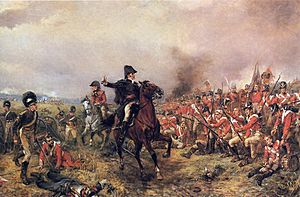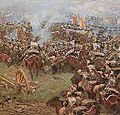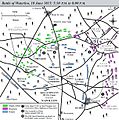Battle of Waterloo facts for kids
Quick facts for kids Battle of Waterloo |
|||||||
|---|---|---|---|---|---|---|---|
| Part of the Hundred Days | |||||||
 Wellington at Waterloo by Robert Alexander Hillingford. |
|||||||
|
|||||||
| Belligerents | |||||||
| Seventh Coalition: |
|||||||
| Commanders and leaders | |||||||
| Strength | |||||||
| 72,000 | Anglo-allies: 68,000 Prussians: 50,000 |
||||||
| Casualties and losses | |||||||
| 25,000 killed and wounded 7,000 captured 15,000 missing |
15,000 British and allies killed and wounded 7,000 Prussians killed and wounded Wellington's army: 3,500 dead; 10,200 wounded; 3,300 missing. Blücher's army: 1,200 dead; 4,400 wounded; 1,400 missing. |
||||||
The Battle of Waterloo was a very important battle fought in 1815. It was between the French army, led by Napoleon Bonaparte, and two other armies. These were the British and Dutch forces, led by the Duke of Wellington, and the Prussian army, led by Marshal Blücher.
Napoleon became the Emperor of France in 1804. He then started a series of wars called the Napoleonic Wars. France quickly built a large empire across Europe. But after losing battles like the Battle of Leipzig, Napoleon was sent away to the island of Elba in 1814.
In February 1815, Napoleon escaped from Elba. He took control of the French army again. He then attacked his enemies in Belgium. The Battle of Waterloo was his final defeat. It marked the end of the Napoleonic Wars.
Napoleon's Rise and Fall
Napoleon was a brilliant military leader. For a long time, it seemed like no one could stop him. But then, two major campaigns failed.
The Russian Disaster
In 1812, Napoleon gathered a huge army. He planned to invade and conquer Russia. However, his army was caught by the harsh Russian winter. Many soldiers died from the cold weather and lack of food. This disaster weakened his power greatly.
After this, countries in Eastern Europe, like Austria and Prussia, formed alliances against him. They pushed his troops back towards France. At the same time, a smaller army in Portugal and Spain fought against Napoleon's forces. This army was led by Arthur Wellesley, who later became the Duke of Wellington. He slowly pushed the French out of Spain.
Exile to Elba
By 1814, Napoleon was facing defeat from all sides. A peace treaty was made. Napoleon agreed to give up his throne. He went to live on a small Mediterranean island called Elba. He was allowed to keep a small army there. Louis XVIII, the brother of the previous king, Louis XVI, became the new ruler of France.
The Hundred Days
Napoleon was not happy on Elba. The new French government had promised him money, but it never arrived. Also, his wife and sons were not allowed to visit him.
He heard that his enemies in France were arguing among themselves. Napoleon saw his chance. In February 1815, he sailed from Elba and landed in France. People in France had mixed feelings about his return. Many were tired of war and the suffering it caused. But others wanted France to be powerful and glorious again. They saw Napoleon as their best hope.
At first, things were uncertain. But Napoleon used his strong leadership skills. He convinced the army to support him. The king panicked and fled the country. This left the way open for Napoleon to return to Paris. He quickly took back his title as Emperor.
The Waterloo Campaign
Napoleon needed time to rebuild and organize the French army. But his enemies were surprised by his return. They knew they had to stop him quickly. Their best chance was to use two armies already in Belgium. One was a British and Dutch army, led by the Duke of Wellington. The other was a Prussian (German) army, led by Marshal Blücher.
Napoleon decided to take another risk. He quickly gathered an army and planned a surprise attack on Wellington and Blücher. He hoped to defeat them before they could join forces. His plan worked at first. He crossed into Belgium before Wellington and Blücher could combine their armies.
Ligny and Quatre Bras
Napoleon's first battle was at Ligny. After a day of fierce fighting, he defeated the Prussian army. They were forced to retreat. Napoleon thought Blücher would go back to Prussia. So, he turned his attention to Wellington.
There had already been a small battle at Quatre Bras. Wellington had fought there to slow down the French advance. This gave him enough time to set up a strong defensive position. It was across the main road to Brussels, near the village of Waterloo.
The French army advanced and set up their camp on a ridge. This ridge faced Wellington's combined British and Dutch (Anglo-Dutch) army. Heavy rain caused delays and made things difficult. Both armies spent the night in the mud, waiting for the battle to begin at dawn.
On June 18, 1815, Napoleon's army faced the Duke of Wellington's Anglo-Dutch army near Waterloo. Wellington's troops were positioned behind a low ridge. This helped protect them from the French cannons.
Phase 1: Attack on Hougoumont
Around 11:00 AM, Napoleon ordered his cannons to fire. French soldiers then began an attack on the Château of Hougoumont. This old house was defended by British Foot Guards. Napoleon wanted this attack to draw Wellington's reserve troops away from the center of the battlefield. This was where Napoleon planned his main attack. Hougoumont was a very important spot for winning the battle.
Phase 2: French Infantry Attacks
At 1:30 PM, Napoleon launched a big attack with his foot soldiers against Wellington's center. Soldiers from the King's German Legion bravely defended the farm of La Haye Sainte. This slowed down the French attack. British cannons and muskets helped stop the French advance.
Then, the British Household and Union heavy cavalry (soldiers on horseback) charged. They chased the French soldiers who were starting to fall back. But the British cavalry got too excited and went too far. They suffered heavy losses from French lancers and light cavalry.
Phase 3: French Cavalry Attacks
By 3:00 PM, it looked like the Anglo-Dutch army was retreating. They had been hit by heavy cannon fire all day. So, Napoleon's general, Marshal Ney, led a massive French cavalry attack against Wellington's center.
However, the British foot soldiers had only moved back to regroup and help the wounded. They quickly formed strong squares. These squares were like human forts that cavalry could not break. The French cavalry suffered terrible losses as they rode around these unbreakable formations of infantrymen.
The situation got even worse for Napoleon. At 4:30 PM, Blücher's Prussian troops launched an attack at Plancenoit, behind Napoleon's army.
Phase 4: Prussians Increase Pressure
By early evening, the French attack at Hougoumont, which was meant as a distraction, was having the opposite effect. The French kept sending more and more troops to fight around the château. It was held by only a small group of British Guardsmen. More French reserves were also sent to deal with the Prussian threat at Plancenoit, behind Napoleon's army.
However, the French finally managed to capture the farm of La Haye Sainte. This was very close to Wellington's center.
Phase 5: Imperial Guard Attacks
Around 7:30 PM, Napoleon used his last reserve troops. This was a final attempt to win the battle. As Prussians arrived to help Wellington's side, veteran soldiers of the French Imperial Guard advanced. They were there to "finish the job."
The British infantry, who were exhausted from constant cannon fire all day, rose to meet them. The musketry (gunfire) from the British Guards Brigade defeated Napoleon's best troops. They ran away, and the entire French army joined them in retreat. Wellington ordered his whole line to advance. The French were driven from the battlefield.
Images for kids
-
Napoleon wanted to defeat the Anglo-allied and Prussian armies one by one.
-
Gebhard Leberecht von Blücher, who led the Prussian Army.
-
Marshal Ney leading the French cavalry charge.
-
Lord Hill asking the French Imperial Guard to surrender.
-
"The Field of Waterloo", by J. M. W. Turner, 1818.
-
"The morning after the battle of Waterloo", by John Heaviside Clark, 1816.
-
Sir David Wilkie, The Chelsea Pensioners reading the Waterloo Dispatch, 1822.
-
The Lion's Mound at Waterloo.
See also
 In Spanish: Batalla de Waterloo para niños
In Spanish: Batalla de Waterloo para niños






































